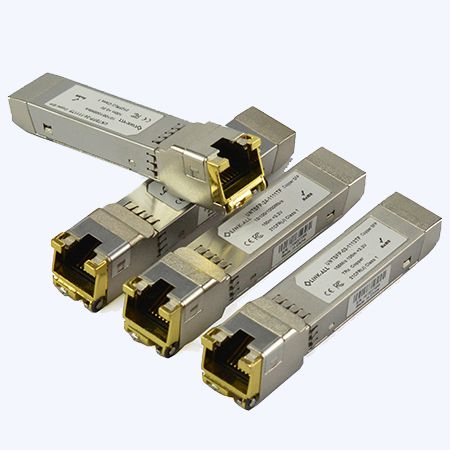


Notes:
1. TX Fault is not used and is always tied to ground.
2. TX Disable as described in the MSA is not applicable to the 1000BASE-T module, but is used for convenience as an input to power on and reset the internal ASIC. This pin is pulled up within the module with a 4.7 KΩ resistor.
Low (0–0.8 V): Transceiver on
Between (0.8 V and 2.0 V): Undefined
High (2.0–3.465 V): Transceiver in power disable state
Open: Transceiver in power disable state
3. Mod-Def 0, 1, 2. These are the module definition pins.
They should be pulled up with a 4.7-10 Kohm resistor on the host board to a supply less than VCCT + 0.3 V or VCCR + 0.3 V.
Mod Def 0 is tied to ground to indicate that the module is present.
Mod-Def 1 is clock line of two wire serial interface for optional serial ID
Mod-Def 2 is data line of two wire serial interface for optional serial ID
4. LVTTL compatible with a maximum voltage of 2.5V.
5. RD-/+: These are the differential receiver outputs. They are ac coupled 100 ohm differential lines which should be terminated with 100 ohm differential at the user SerDes. The ac coupling is done inside the module and is thus not required on the host board. The voltage swing on these lines will be between 370 and 2000 mV differential (185 – 1000 mV single ended) when properly terminated. These levels are compatible with CML and LVPECL voltage swings.
6. VCCR and VCCT are the receiver and transmitter power supplies. They are defined as 3.3 V ± 5% at the SFP connector pin. The maximum supply current is about 300mA and the associated in-rush current will typically be no more than 30 mA above steady state after 500 nanoseconds.
7. TD-/+: These are the differential transmitter inputs. They are ac coupled differential lines with 100 ohm differential termination inside the module. The ac coupling is done inside the module and is thus not required on the host board. The inputs will accept differential swings of 500 – 2400 mV (250 –1200 mV single ended), though it is recommended that values between 500 and 1200 mV differential (250 – 600 mV single ended) be used for best EMI performance. These levels are compatible with CML and LVPECL voltage swings.
1. 支持热插拔
2. 金属外壳,抗电磁干扰
3. 低能量损耗
4. RJ45接头
5. +3.3V 电压标准
6. 10/100/1000 BASE-T标准,支持SGMII接口
7.支持SFP MSA
8. 支持IEEE Std 802.3TM-2002
9. RoHs 认证
10. 操作温度范围 0°C to +70°C
1. 高速以太网
2. 交换机与路由器之间的连接
3. 高速文件传输
